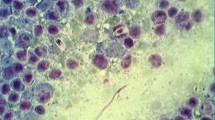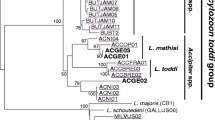Abstract
Probable arthropod vectors of avian blood protozoa, Leucocytozoon lovati, were collected in the alpine regions of Japan, the habitats of the host birds of Japanese rock ptarmigan (Lagopus mutus japonicus). Seven alpine regions of Japan, Asahidake, Chogatake, Tateyama, Jiigatake, Norikura, Kitadake, and Senjyogatake were investigated for black fly collection during 2004 to 2007. The collected 490 insects were morphologically identified as six species of female black flies, including Prosimulium hirtipes group (n = 59), Prosimulium mutata (n = 13), Prosimulium yezoense (n = 10), Similium japonicum (n = 359), Similium uchidai (n = 39), and Twinnia japonensis (n = 10). Extracted DNAs from individual black fly species were utilized for the amplification of the partial mitochondrial cytochrome b gene sequences of Leucocytozoon lovati previously reported. Four S. japonicum, two S. uchidai, and two P. hirtipes group studied were positive for the nested PCR among 490 black flies collected (1.6%; 8/490). All amplified sequences from the black flies were completely identical to those of L. lovati previously detected from Japanese rock ptarmigan. Our results suggest that at least three species of black flies, S. japonicum, S. uchidai, and P. hirtipes group, studied in this area could be regarded as potential vectors for L. lovati in the rock ptarmigan. This is the first detection case of Leucocytozoon from black flies of Japan.

Similar content being viewed by others
References
Akiba K (1960) Studies on the Leucocytozoon found in the chicken, in Japan: II. On the transmission of L. caulleryi by Culicoides arakawae. Jpn J Vet Sci 22:309–319
Atkinson CT, Van-Riper C (1991) Pathogenicity and epizootiology of avian 15 haematozoa: Plasmodium, Leucocytozoon and Haemoproteus. In: Loye JE, Zuk M (eds) Bird–Parasite Interactions: Ecology, Evolution and Behaviour. University of Oxford Press, Oxford, pp 19–48
Ejiri H, Sato Y, Sasaki E, Tsuda Y, Matsui S, Takagi M, Omori S, Murata K, Yukawa M (2008) Detection of avian Plasmodium spp. DNA sequences from mosquitoes captured in Minami Daito Island of Japan. J Vet Med Sci 70, in press
Hagihara M, Yamaguchi T, Kitahara M, Hirai K, Murata K (2004) Leucocytozoon infection found in wild rock ptarmigans (Lagopus mutus) from Japan. J Wildlife Dis 40:804–807
Haneda K, Nakamura H, Koiwai A, Iizawa T, Tajima K (1985) Distribution and density of the Rock Ptarmigan Lagopus mutus in the Southern Japan Alps. Tori 34:33–48 (in Japanese with English summary)
Hellgren O, Bensch S, Malmqvist B (2008) Bird hosts, blood parasites and their vectors—associations uncovered by molecular analyses of blackfly blood meals. Mol Ecol 17:1605–1613
Kilpatrick AM, Kramer LD, Campbell SR, Alleyne EO, Dobson AP, Daszak P (2005) West Nile virus risk assessment and the bridge vector paradigm. Emerg Inf Dis 11:425–429
Kilpatrick AM, Daszak P, Goodman SJ, Rogg H, Kramer LD, Cedano V, Cunninghan AA (2006) Predicting pathogen introduction: West Nile virus spread to Galáipagos. Conserv Biol 20:1224–1231
Massey B, Gleeson DM, Slaney D, Tompkins DM (2007) PCR detection of Plasmodium and blood meal identification in a native New Zealand mosquito. J Vector Ecol 32:154–156
Molaei G, Andreadis TG, Armstrong PM, Anderson JF, Vossbrinck CR (2006) Host feeding patterns of Culex mosquitoes and West Nile virus transmission, northeastern United States. Emerg Inf Dis 12:468–474
Morii T (1992) A review of Leucocytozoon caulleryi infection in chickens. J Protozool Res 2:128–133
Murata K (2002) Prevalence of blood parasites in Japanese wild birds. J Vet Med Sci 64:785–790
Murata K, Tamada A, Ichikawa Y, Hagihara M, Sato Y, Nakamura H, Nakamura M, Sakanakura T, Asakawa M (2007) Geographical distribution and seasonality of the prevalence of Leucocytozoon lovati in Japanese rock ptarmigans (Lagopus mutus japonicus) found in the alpine regions of Japan. J Vet Med Sci 69:171–176
Murata K, Nii R, Yui S, Sasaki E, Ishikawa S, Sato Y, Matsui S, Horie S, Akatani K, Takagi M, Sawabe K, Tsuda Y (2008) Avian malaria infection in wild birds inhabiting South Borodino Island in the Okinawa Archipelago, Japan. J Vet Med Sci 70:501–503
Nagata H (2006) Reevaluation of the prevalence of blood parasites in Japanese Passerines by using PCR based molecular diagnostics. Ornithol Sci 5:105–112
Perkins SL, Schall JJ (2002) A molecular phylogeny of malarial parasites recovered from cytochrome b gene sequences. J Parasitol 88:972–978
Saito K, Kanayama K (1988) Studies on the Ecology of Blackflies (Diputera: Simuliidae). XII. Blackfly Fauna in Toyama Prefecture. Jpn J Appl Ent Zool 32:43–48 (in Japanese with English summary)
Saito K, Kanayama A (2001) Studies on the ecology of blackflies (Diptera: Simuliidae). 40. Fauna of the Blackflies in Nagano Prefecture in autumn. Med Entomol Zool 52:49–57 (in Japanese with English summary)
Saito K, Kanayama A, Uemoto K (1996) Studies on the ecology of blackflies (Diptera: Simuliidae). 32. Fauna of the blackflies in Gifu Prefecture in summer. Med Entomol Zool 47:379–386 (in Japanese with English summary)
Sato Y, Hagihara M, Yamaguchi T, Yukawa M, Murata K (2007) Phylogenetic comparison of Leucocytozoon spp. from wild birds of Japan. J Vet Med Sci 69:55–59
Steele EJ, Noblet GP (1993) Gametocytogenesis of Leucocytozoon smithi. J Eukaryot Microbiol 40:384–391
Steele EJ, Noblet GP, Noblet R (1992) Sporogonic development of Leucocytozoon smithi. J Protozool 39:690–699
Steele EJ, Noblet GP (2001) Gametogenesis, fertilization and ookinete differentiation of Leucocytozoon smithi. J Eukaryot Microbiol 48:118–25
Thompson JD, Higgins DG, Gibson TJ (1994) CLUSTAL W: improving the sensitivity of progressive multiple sequence alignment through sequence weighting, positions-specific gap penalties and weight matrix choice. Nucleic Acids Res 22:4673–4680
Uemoto K, Onishi O, Orii T (1973) Revision of the Genus Prosimulium Roubaud (Diptera, Simuliidae) of Japan: I. hirtipes-group in the Subgenus Prosimulium. Jpn J Sanit Zool 24:27–46
Valkiunas G (2005) Avian malaria parasites and other Haemosporidia. CRC, Boca Raton
Acknowledgments
This study was partially supported by a Grant-in-Aid for Scientific Research (No. 16510179) from the Japan Society for the Promotion of Science, the Academic Frontier Project “Surveillance and control for zoonoses” and “High-Tech Research Center” Project for Private Universities from MEXT of Japan, Nihon University Joint Research Grant for YS, MY and KM (2007) and Global Environment Research Fund of the Ministry of the Environment of Japan (F-062) for YS and KM.
Author information
Authors and Affiliations
Corresponding author
Rights and permissions
About this article
Cite this article
Sato, Y., Tamada, A., Mochizuki, Y. et al. Molecular detection of Leucocytozoon lovati from probable vectors, black flies (Simuliudae) collected in the alpine regions of Japan. Parasitol Res 104, 251–255 (2009). https://doi.org/10.1007/s00436-008-1183-1
Received:
Accepted:
Published:
Issue Date:
DOI: https://doi.org/10.1007/s00436-008-1183-1




